Here's the second of my two ECW command vignettes. In was way back in May 2009 that I started painting a Royalist force for the English Civil War - my efforts can be seen here. I began work on two command stands, one for the complete army and a second for its (forthcoming) cavalry element (Sir John Byron). I painted 3 of the figures and began work on 2 cornets, but failed to complete them; I think it was painting the cornets' grey horses that scared me off. As I said yesterday, I eventually finished these stands in February last year, together with several things that had lain half-finished over the past few years (including lots of Darkest Africa arabs and beluchis, which I might blog about at some stage). This stand feature Sir Ralph Hopton with his escort and cornet. Hopton is a personality figure from the Bicorne Miniatures range; the other two figures are Renegade, I think.
Sir Ralph Hopton (1596-1652) is one of the better known characters of the ECW, leading the Royalist charge in the West Country. He was MP for Shaftesbury from 1621 and then gained early military experience as part of the entourage of Queen Elizabeth of Bohemia (Prince Rupert's mother), whose husband, in 1620, was defeated in battle and deposed by the Holy Roman Emperor. He saw further action in the early stages of the Thirty Years' War before returning to England to become MP for Bath in 1625. He returned to the army in 1639 to serve the King in the Bishops' Wars as a captain in the King's Lifeguard. In 1640, Hopton became MP for Somerset in the Short Parliament and for Wells in the Long Parliament and was active in supporting the King against his political enemies. He supported Charles' attempt to arrest five members of the Commons in January 1642 and was subsequently arrested and imprisoned in the Tower for 2 weeks.
In summer 1642 Hopton went to Cornwall to raise the county for the King, which he managed to do by mobilising the militia and driving out the local Parliamentarians. He then recruited a local army and won his first victory of Braddock Down in January 1643. A further victory at Stratton enable Hopton to meet with reinforcements from Prince Maurice and the Earl of Hertford and march into Somerset, where the Royalists won a pyhrric victory over Sir William Waller at Lansdown in July. Among the heavy Royalist casualties was Hopton himself, who was injured and temporarily blinded after the battle when an ammunition cart exploded. The Royalists regrouped, were joined by reinforcements under Lord Wilmot and then won a more decisive victory over Waller at Roundway Down a week later. Joined by Prince Rupert, Hopton's army then captured Bristol. Hopton was appointed lieutenant-governor of the city and raised to the peerage as Baron Hopton of Stratton. He was then appointed as commander of Royalist forces in south-western England and ordered to advance on London.
Hopton captured Arundel Castle in Sussex in December 1643, but his march on London was checked by Waller at the battle of Cheriton in March 1644. After a brief return to Bristol, Hopton was appointed General of Ordnance and fought at the second battle of Newbury in October 1644. The following spring saw Hopton besieging Taunton, but the defeat at Naseby meant the effective end of the Royalist military struggle and Hopton withdrew to Devon. Hopton held his army together long enough to enable the Prince of Wales to escape to the Continent and then surrendered in March 1646. He too went into exile and, after providing some further assistance to Prince Charles, died in Bruges in September 1652.
I've always had a soft spot for Hopton and his dashing Cornish army. He rather reminds me of Cornwallis in the southern campaigns, winning most of the battles but ultimately losing the war. There's a rather bad painting mistake on the Hopton figure. I clearly confused myself about what clothes he's wearing, and assumed that the buff coat was some sort of tabard such that the visible sleeves would be those of an under-coat or tunic. On reflection, that's wrong - the sleeves should also be buff as they are part of the same coat, although the light blue does give quite a nice contrast to what otherwise would be a buff-heavy vignette. Portraits of Hopton, like the one above, also show a slight goatee beard, but I didn't see one on the figure so he's clean shaven here. I also notice that the gloves of the chap with the pistol look rather yellow - they remind me of the Marigolds that my mother used to wear when doing the dishes. But I remember when painting this figure that I wanted a slightly different colour for the cavalryman's gloves, otherwise everything would look, well, "buffy". As for the cornet's horse - I have no idea what I was doing there, but, while the dappled effect probably isn't 100% quite right, at least it's a change from plain white or grey.
3 figures. Painted May 2009 and February 2012.
Showing posts with label English Civil War. Show all posts
Showing posts with label English Civil War. Show all posts
Friday, 27 September 2013
Thursday, 26 September 2013
Sir John Byron
Sorry for the lack of posts this month - real life catching up again. Also, I don't really have much in the way of new stuff anyway; I have too many different things on the go and I'm not concentrating sufficiently on finishing units before starting others. That said, there will, I hope, be new AWI militia posted on Sunday and I'm almost ready for a mass of ACW posts. To tide things over, for the next couple of days I'm going to post about a couple of ECW pieces I painted a good while ago (as long ago as 2009, in fact) and didn't bother talking about at the time.
This is a vignette of Sir John Byron, a staunch supporter of the Royalist cause. Born in 1599, he became MP for Nottingham in 1624 and was knighted two years later. From 1634 to 1635 he was High Sheriff of Nottinghamshire and then Lieutenant of the Tower of London in 1641, although he was forced to give up this latter post as his appointment was opposed by the House of Commons. He was clearly in very good favour with King Charles, because at some point he became a Gentleman of the Bedchamber (this strange-sounding position was basically a personal servant to the king; according to Wikipedia, the post involved "guarding the royal water-closet", which can't have been much fun when it was in royal use). In October 1643 he was created 1st Baron Byron of Rochdale.
In terms of his military service, Byron began the civil was as commander of a cavalry regiment, which saw action at Edgehill. His ability as a leader of cavalry resulted in him commanding the Royalist right wing at Roundway Down in 1643 and then the centre at the First Battle of Newbury. Subsequent to his actions in those battles he was ennobled and appointed commander of Royalist forces in Lancashire and Cheshire. His siege of the town of Nantwitch in January 1644 was destroyed by a relief force under Fairfax. In July that year we find him commanding the Royalist right wing at Marston Moor. After the defeat Byron withdrew to Chester, which he defended against various Parliamentarian sieges until being forced to surrender in February 1646. In 1648 the future Charles II sought Byron's assistance in what became known as the Second Civil War, but Byron failed to raise support for the Royalist cause in Wales and fled to Ireland. He appears to have realised that the Royalist resurgence was doomed and headed off to France to join the Duke of York (i.e. the future James II), who was spending his exile serving in the French army. Byron died at Paris in August 1652. As he had no children his baronetcy passed to his younger brother, Richard (see below) and then, after three more barons, to the poet Lord Byron.
This command stand is intended to use as a generic "cavalry wing" commander. The Byron figure is actually a personality figure of his brother, Richard, that was originally a subscriber freebie from Wargames Illustrated. It is now available from North Star as part of their Trent Miniatures "Newark Characters" range. I believe Mark Copplestone was the sculptor. Richard Byron (1606-1679) was a governor of Newark and also fought in the ECW on the Royalist side, being knighted in 1642. Judging from the fine portrait of John Byron by William Dobson (which is on the left and is also on the cover of Stuart Reid's ECW history "All the King's Armies") the two brothers looked pretty similar. I wanted a cavalry commander for my Royalist army and thought the Byron figure would fit the bill. The cornet is from either Renegade or Bicorne - I confess I can't now recall which. I remember painting the Byron figure well before I left London, and in fact I've found a photo from July 2009 that shows him finished; however the vignette's completion was delayed by the cornet, as I developed a bit of a mental block about painting the horse. Then in February 2012 I made a conscious effort to finish off various things that I had been working on for too long. I must make a more general conscious effort to paint more ECW at some stage.
2 figures. Painted June 2009 and February 2012.
This is a vignette of Sir John Byron, a staunch supporter of the Royalist cause. Born in 1599, he became MP for Nottingham in 1624 and was knighted two years later. From 1634 to 1635 he was High Sheriff of Nottinghamshire and then Lieutenant of the Tower of London in 1641, although he was forced to give up this latter post as his appointment was opposed by the House of Commons. He was clearly in very good favour with King Charles, because at some point he became a Gentleman of the Bedchamber (this strange-sounding position was basically a personal servant to the king; according to Wikipedia, the post involved "guarding the royal water-closet", which can't have been much fun when it was in royal use). In October 1643 he was created 1st Baron Byron of Rochdale.
In terms of his military service, Byron began the civil was as commander of a cavalry regiment, which saw action at Edgehill. His ability as a leader of cavalry resulted in him commanding the Royalist right wing at Roundway Down in 1643 and then the centre at the First Battle of Newbury. Subsequent to his actions in those battles he was ennobled and appointed commander of Royalist forces in Lancashire and Cheshire. His siege of the town of Nantwitch in January 1644 was destroyed by a relief force under Fairfax. In July that year we find him commanding the Royalist right wing at Marston Moor. After the defeat Byron withdrew to Chester, which he defended against various Parliamentarian sieges until being forced to surrender in February 1646. In 1648 the future Charles II sought Byron's assistance in what became known as the Second Civil War, but Byron failed to raise support for the Royalist cause in Wales and fled to Ireland. He appears to have realised that the Royalist resurgence was doomed and headed off to France to join the Duke of York (i.e. the future James II), who was spending his exile serving in the French army. Byron died at Paris in August 1652. As he had no children his baronetcy passed to his younger brother, Richard (see below) and then, after three more barons, to the poet Lord Byron.
This command stand is intended to use as a generic "cavalry wing" commander. The Byron figure is actually a personality figure of his brother, Richard, that was originally a subscriber freebie from Wargames Illustrated. It is now available from North Star as part of their Trent Miniatures "Newark Characters" range. I believe Mark Copplestone was the sculptor. Richard Byron (1606-1679) was a governor of Newark and also fought in the ECW on the Royalist side, being knighted in 1642. Judging from the fine portrait of John Byron by William Dobson (which is on the left and is also on the cover of Stuart Reid's ECW history "All the King's Armies") the two brothers looked pretty similar. I wanted a cavalry commander for my Royalist army and thought the Byron figure would fit the bill. The cornet is from either Renegade or Bicorne - I confess I can't now recall which. I remember painting the Byron figure well before I left London, and in fact I've found a photo from July 2009 that shows him finished; however the vignette's completion was delayed by the cornet, as I developed a bit of a mental block about painting the horse. Then in February 2012 I made a conscious effort to finish off various things that I had been working on for too long. I must make a more general conscious effort to paint more ECW at some stage.
2 figures. Painted June 2009 and February 2012.
Friday, 11 December 2009
ECW Interlude (7)
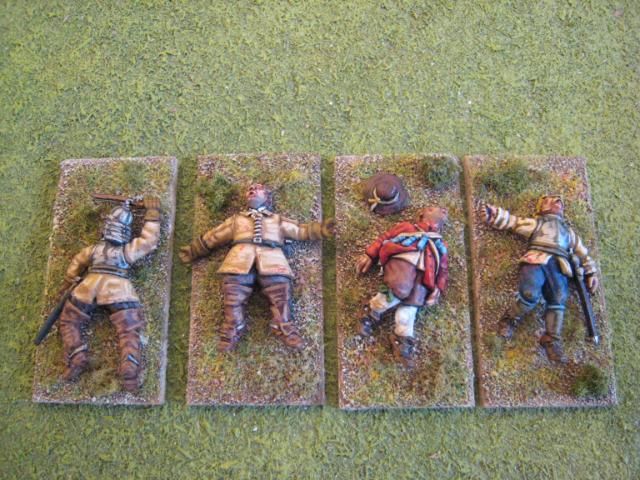
Looking through Photobucket I realised I hadn't posted pics of these ECW casualty figures. Although a tad gruesome, I thought that I might as well put up the pics since posts are going to thin down rather once the little one finally makes its appearance (8 days overdue now). These are Bicorne figures. The pack gives you 4 "falling wounded" figures and 4 prone ones. It seemed appropriate to dirty up these figures, so I added a bit of gore and pastel mud. The NMA infantryman's hat is from Warlord Minatures - they sell extra metal hat packs for their plastic ECW range, which I can see are likely to come in useful for larger command bases and things like this where the figures have lost their headgear. I haven't added weapons and I'm thinking these may well have been picked up by others who had perhaps lost their weapons or had them knocked out of their hands.
I'll post some more First Carlist War stuff next week. I'm waiting for some more matt varnish to be delivered, which has delayed the basing of my National Militia regiment. I'm close to finishing the 7th Foot for the AWI (the Royal Fuziliers) and have started a Hessian grenadier battalion. At some point before the end of the year I want to do some "test" Carlist infantry and finish off my first unit of Crusader foot for the First Crusade (current wip pic below).
4 figures. Painted November 2009.
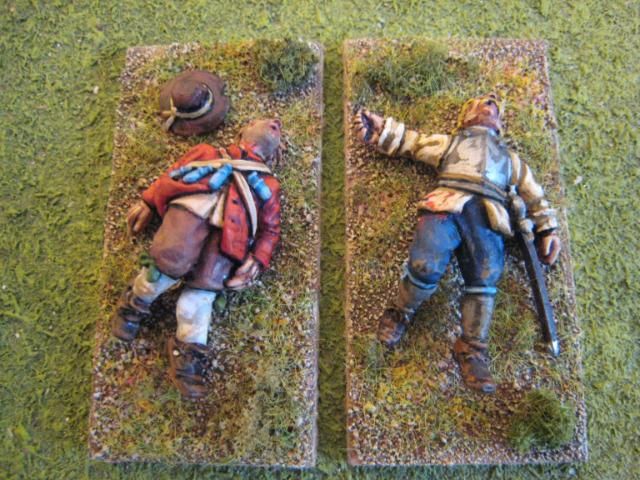
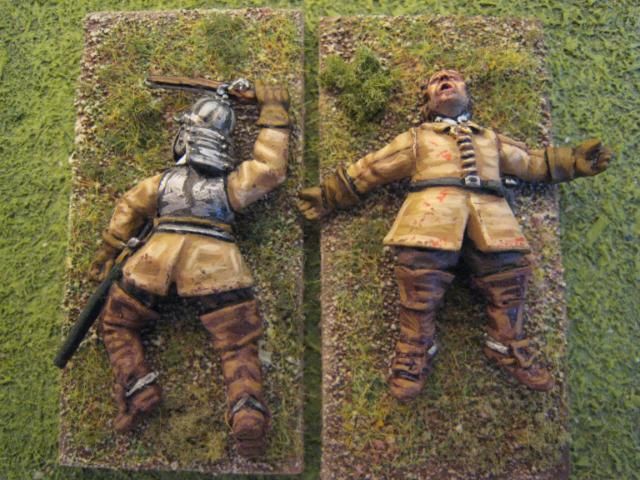

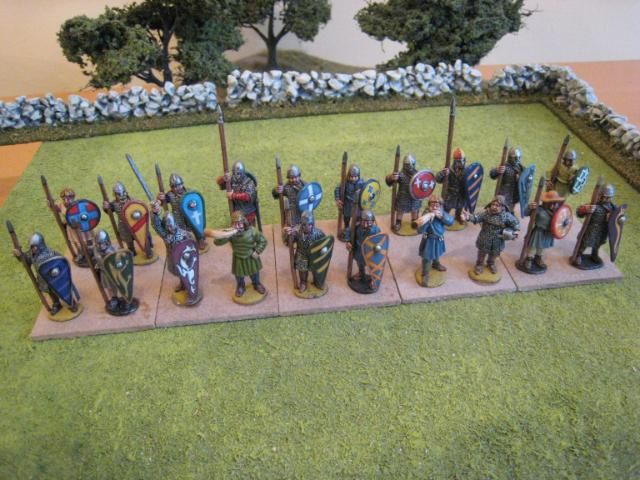
Wednesday, 2 December 2009
ECW Interlude (6)
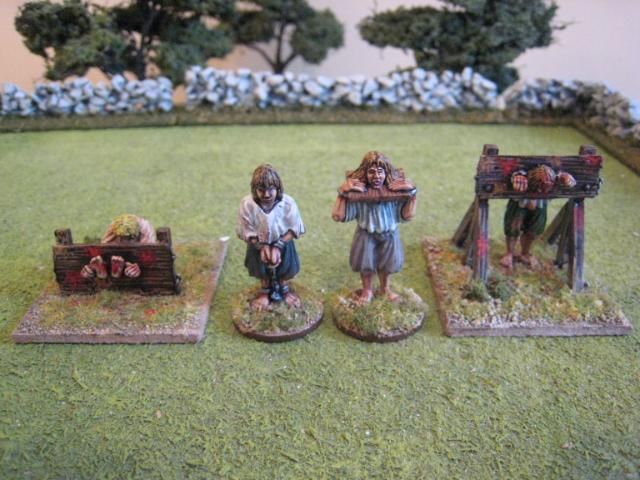
This is a pack called "punishment set" from Redoubt Enterprises. I saw it on their stand at SELWG and had one of those "must buy" moments. I didn't know much about Redoubt's range, although I had heard that it is supposed to be compatible with Renegade and Bicorne. The figures match the former, certainly, but they are fair bit larger than Bicorne, particularly the later Bicorne figures which can be smaller than the earlier ones. These figures are about 32mm high; given that they don't wear hats that's pretty big. But if you don't mind the size the Redoubt range is worth investigating as it has lots of tasty vignettes - Scottish camp followers, a court martial set, a dragoon demolition party, forlorn hope figures etc. Many of these figures, like the ones here, have a far wider application than just the ECW.
These were fun and quick to paint. I canvassed ideas on the WD3 Forum as to what sort of things might have been thrown at people in stocks. I recently saw on tv a stocks victim being abused in an episode of "Garrow's Law", a series about an Old Bailey defence lawyer in the early 1790s: this chap was being pelted with tomatoes, eggs, radishes and lettuces before being put out of his misery with a well-aimed stone to the forehead. Dung was a popular suggestion on WD3 so I painted the missile splatter in red for tomatoes and a light/medium brown for dung. I tried to place these so that there would be some "direct hits" and some "near misses", together with some completely "wild misses". I used some red flower scatter to suggest bits of tomatoes lying on the ground. It also seemed probable that missiles would be aimed at the rear of the victims, not just the front, so I added some splatter on the most prominent rear-facing parts. I also added lots of mud and dirt to the clothes and feet....I tried to search the internet to see if anyone still makes life-size stocks; unfortunately Google quickly takes you into more general "punishment" sites which are most definitely not work PC friendly.
On the painting front I've finished another couple of First Carlist War units and am well stuck into a third. I have also started work on another AWI British line regiment, with a backpack motif that I am having a bit of trouble with. The Perries' recent announcement on TMP about forthcoming additions to their AWI range brought a tear to my eye (and if I was pregnant I'm sure would have brought the immediate onset of labour). The news sent me scurrying to my "British Grenadier!" scenario books to see what French regiments I "need"; to which the answer is "lots". So I'm looking forward to getting well stuck in to the AWI again next year.
4 figures. Painted November 2009.

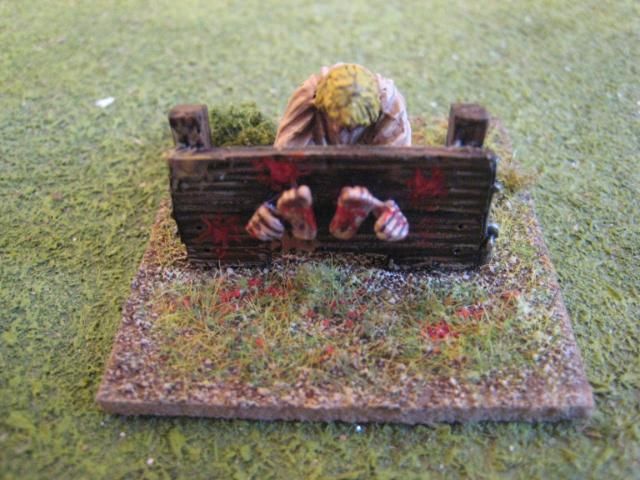
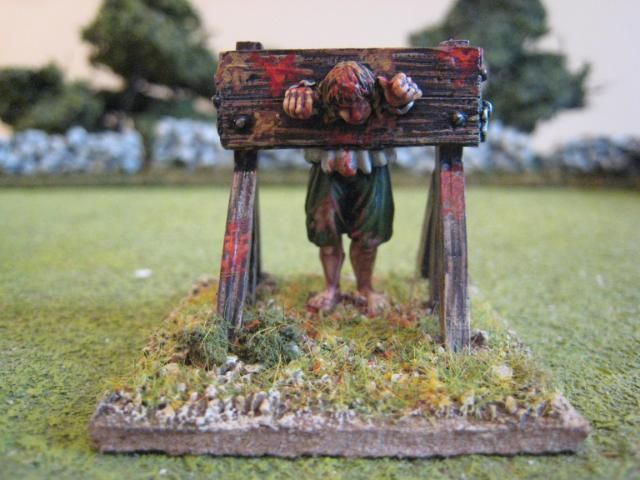

Friday, 13 November 2009
ECW Interlude (5)
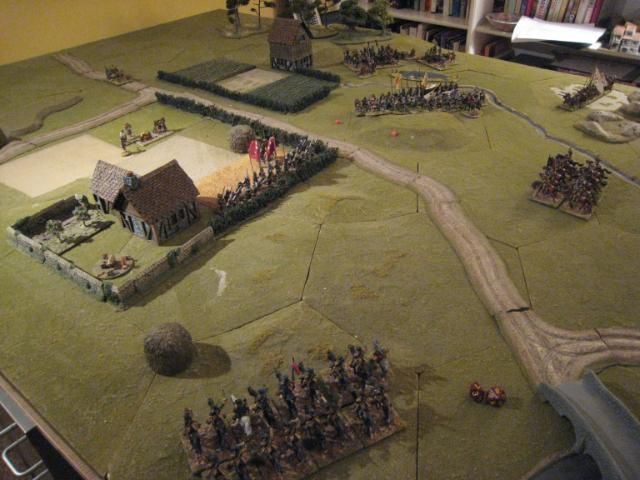
Last Wednesday evening I headed up to north London for a try-out ECW experience with Eclaireur and chum Timmo. This was the first time that EC and I had used the "Forlorn Hope" rules; Timmo was on hand as a veteran of these particular rules (he even had a first edition copy of the, er, first edition!). I brought up my modest ECW collection of 3 foot regiments and some vignettes, although in the end only Rupert's Foot went on the table as EC's collection has outstripped mine by some distance. EC's troops are a mix of Warlord and Perry, with a few Bicorne mixed in; the photos below show how well they fit together. As I've said on other fora, I think that Bicorne provide a good central point for ECW figures - you can then "go large" by mixing them with Renegade and Reboubt or "go small" by mixing in Perry and Warlord. I've gone the former route, but Rupert's Foot did not look significantly larger than their opponents, so there is clearly scope for extensive mixing and matching in this period.
We didn't play out a battle but rather tested different types of combat. Rupert's Foot advanced against a Parliament regiment to try out infantry combat. A little later we had some cavalry charge more Parliament foot that had deployed behind a hedge. The mechanics of "Forlorn Hope" certainly take some getting used to. I found the calculation method for firing rather confusing and the melee result for the cavalry charge produced a very one-sided result, with the infantry breaking immediately - they didn't see to have any + modifier for being behind a hedge and so "in cover". As a player you clearly need to be wise to the effect that troop grading and the ratio of pike to musket have on your ability to fire and melee effectively. Orders also have an important role as there seem to be several different "advance" orders that a unit can be on, and which influence what you can do. So a bit of home play will be required to get the hang of the rules.
Apologies for the lack of posts of late. I actually have 3 units painted and varnished, but as yet unbased due to the chaos caused by having 2 bathrooms re-fitted and a general tidy-up of the rest of the house. Thanks to that, and also work, I've only finished 3 figures since the end of the previous weekend, which I think is an all-time low. But I'm going to see if I can crank up production a bit over the last couple of weeks before BBE (Before Baby Era). I'm currently trying to finish two First Carlist War regiments and some more Crusaders, the latter in order to try out some new Foundry triads that I bought in their recent 20% off sale (the new WW2 colours mostly).
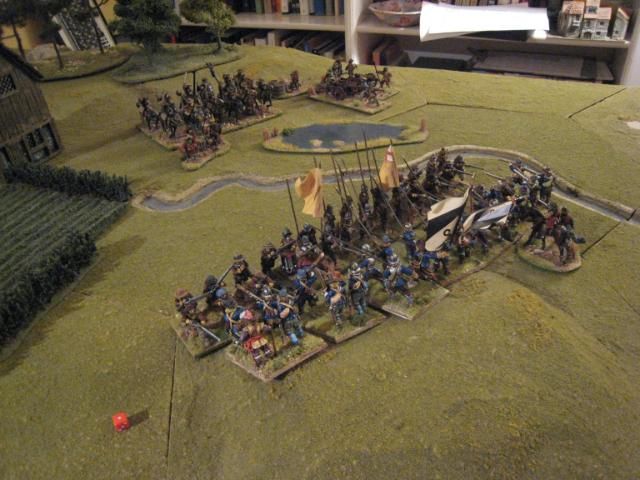
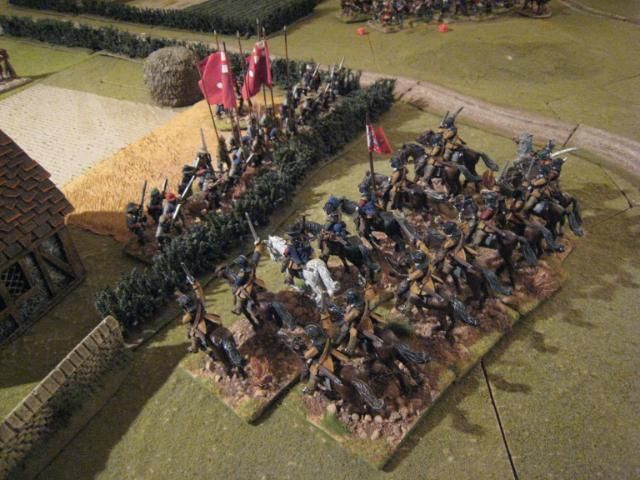
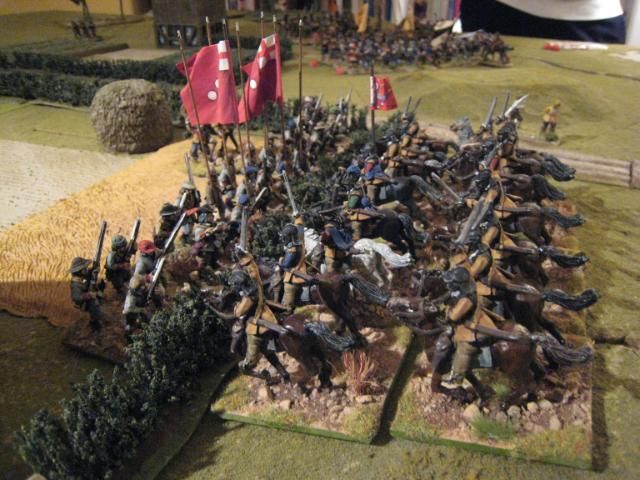
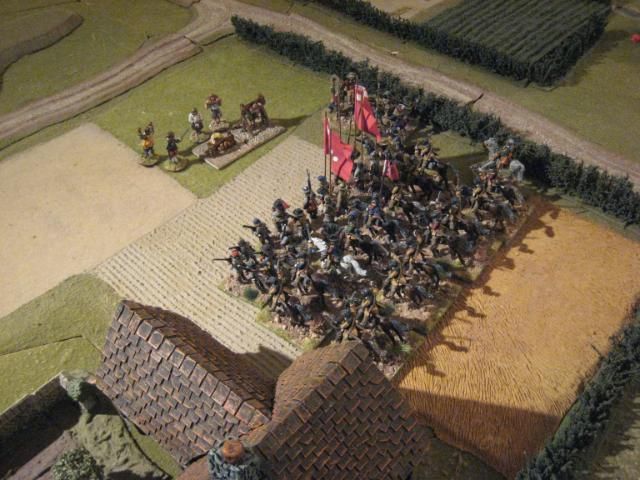
Friday, 25 September 2009
ECW Interlude (4)
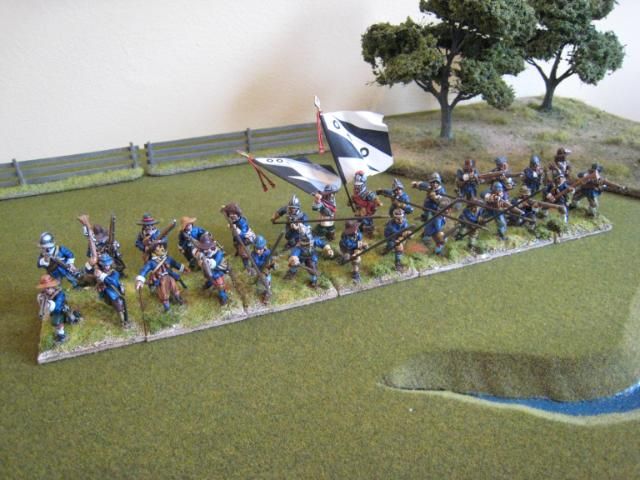
I've delayed posting about my latest ECW regiment because, frankly, the pics are pretty rubbish. I can't seem to focus properly on figures with lots of pikes and other protrusions - I'm sure there is a depth of field setting on my Canon that I haven't found yet. But here are some photos of Prince Rupert's Foote, the third regiment in my slowly developing Royalist force-ette. I chose this regiment because of its distinctive flags and smart blue coats.
The regiment was raised in 1642 by Sir Thomas Lunsford and was initially named after him. Lunsford was captured at Edgehill and command of the regiment passed to his brother, Sir Henry Lunsford. Sir Henry was killed during the Siege of Bristol in July 1643, at which point Prince Rupert assumed command. The rgeiment fought in Rupert's Lancashire campaigns and took part in the relief of Latham House and the sieges of Bolton and Liverpool. The regiment also fought at Marston Moor. In 1645 the regiment took part in the storming of Leicester and was badly mauled at Naseby. The survivors ended the war as part of the Bristol garrison.
The figures here are all Bicorne and Renegade. I followed information on the Sealed Knot site about blue coats and grey trousers, although I mixed in various other shades for the latter. I decided to move up from 24 to 28 figures because I wanted to have a decent number of pikes - you buy lots of packs of pikemen to have a variety of poses to choose from but then find that you only use 5 or 6 of them in each regiment.
28 figures. Painted July/August 2009. Flags by GMB.
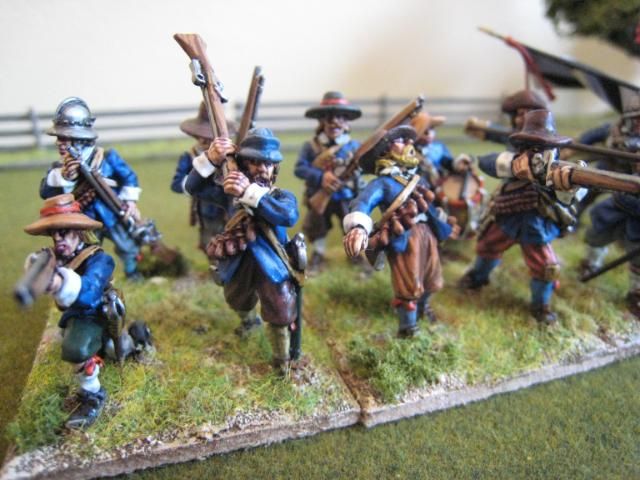
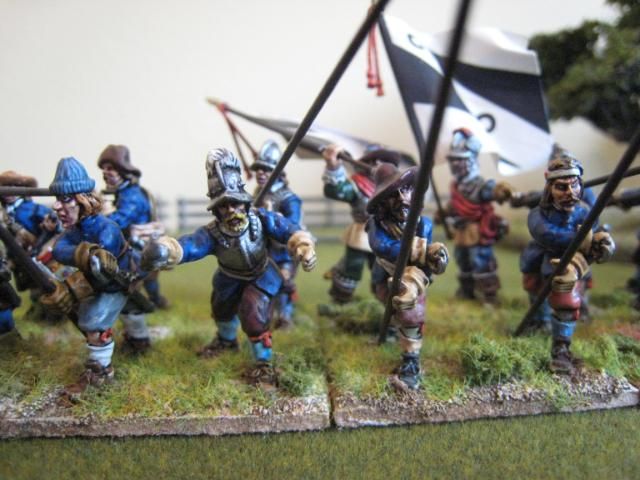
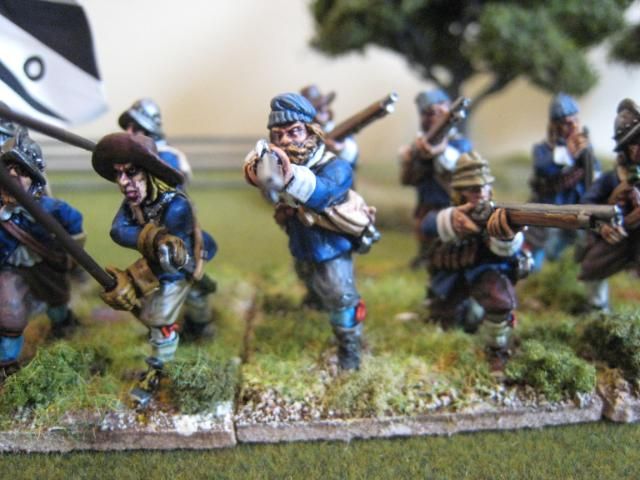
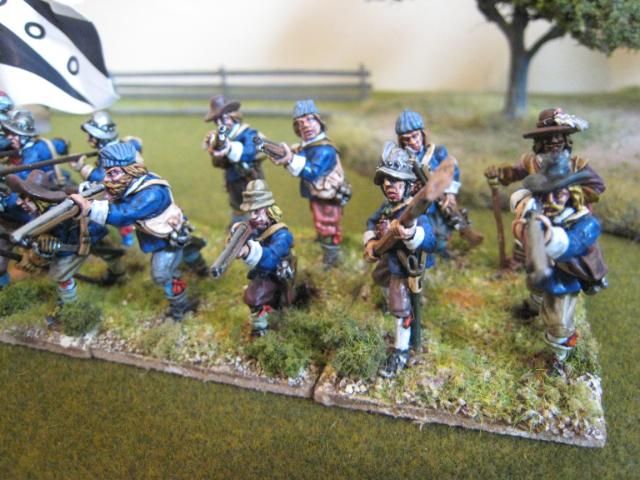
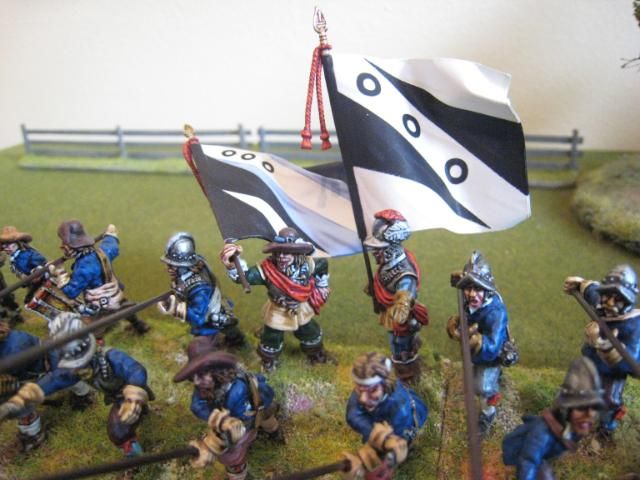
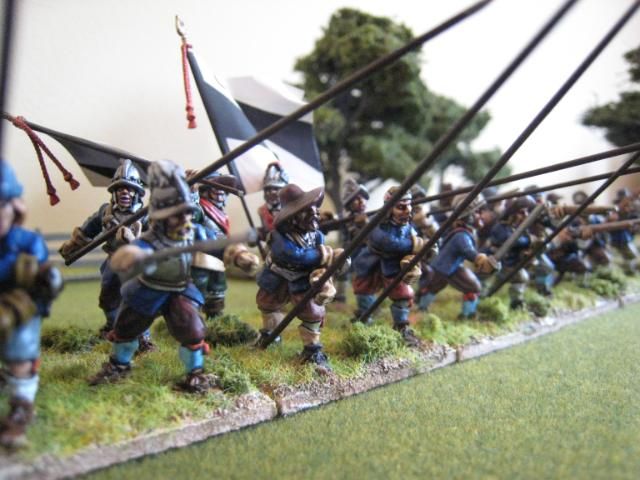
Thursday, 23 July 2009
ECW Interlude (3)

I've jumped ahead of the queue a bit to post some pics of my second ECW foot regiment, the Earl of Northampton's regiment (Royalist). There were two regiments that bore Northampton's name, one of foot and one of horse. At the start of the war, the Earl of Northampton was Spencer Compton, the second ascendant to the earldom.
The foot regiment was raised in Oxfordshire partly by the second son of the Earl, William Compton. After the battle of Edgehill on 27th October 1642, the regiment was garrisoned in Banbury Castle. The castle was besieged by Parliament from July to 25 October 1644, at which point the siege was raised by William's older brother James, by that time the new Earl of Northampton. The 20-year old William received a knightood for his defence of Banbury Castle. The regiment eventually surrendered itself to Parliament in May 1646 after a second siege of Banbury. William was apparently one of the founder members of the original Sealed Knot, a covert organisation founded in 1652 with the aim of restoring the Stuart monarchy.
The regiment of horse was raised in 1642 in Oxfordshire and surrounding areas by the Spencer Compton. The Earl was a veteran of the Thirty Years' War, in which he served with Prince Rupert under the Prince of Orange, and a friend of the King. He commanded this horse regiment until he was killed at Hopton Heath in March 1643. Apparently his horse fell after tripping in rabbit warrens and the Earl found himself surrounded by roundheads. He refused to surrender, allegedly saying "I scorn to take quarter from such base rogues and rebells as yourselves!" His reward for such spirited eloquence was to have his head cleaved by a halberd. That's Roundheads for you....
I chose this regiment for the simple reason that I liked the combination of green coats and red trousers. This uniform was taken from the Sealed Knot's recreated regiment, and I have no idea how accurate it is. I decided at the outset of this project that I was not going to worry unduly about accuracy - I just want a collection of regiments that look pretty and have a modicum of connection to real historical units. I mixed up the colours of the trousers a bit, but the coats were painted in just two combinations of dark green, so the look is fairly uniform. The flags are generic ones from GMB which are closest to those shown on the relevant page of the Sealed Knot's site. The figures are the usual mix of Renegade and Bicorne, mainly the latter.
There is the prospect of a game at some stage in August and so I'm trying to squeeze in as much ECW stuff as I can at the moment. Hopefully at the weekend I will finish off my two command stands and come to a decision about basing the artillery (painted but unbased now since early June). I'm also hard at work on Prince Rupert's regiment of foot, and I need to get cracking on some horse too. I'll post some more Carlist War figures at the weekend and will also try to do a report of the recent big game with the Perries.
24 figures. Painted June/July 2009. Flags by GMB.

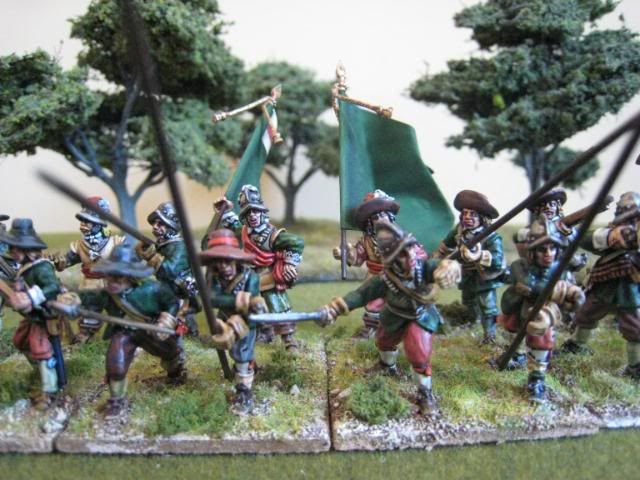
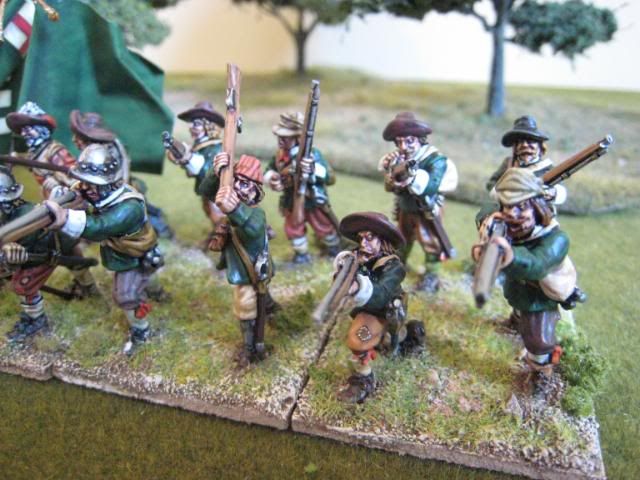
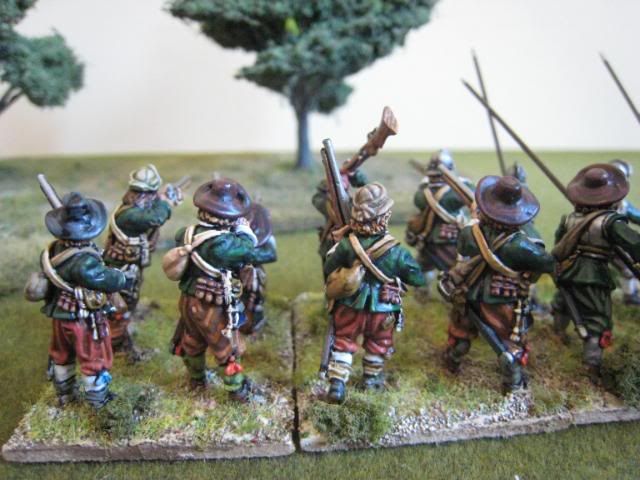
Saturday, 18 July 2009
ECW Interlude (2)
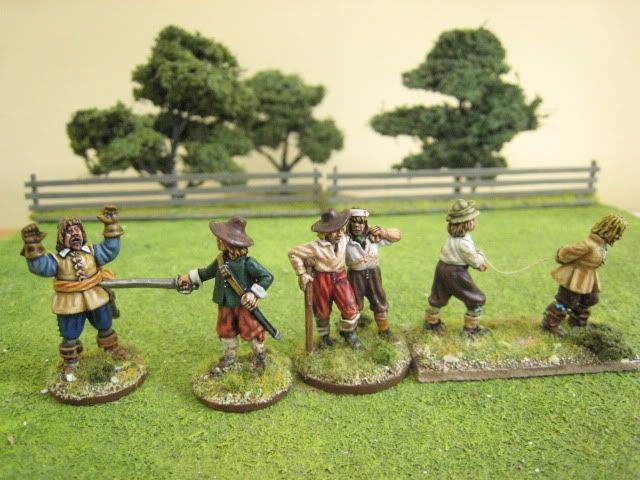

I now have quite a backlog of stuff, so expect a flurry of posts over the next few days. Before I dash off into town to book the flights for my next trip to NZ, here is Bicorne Miniatures' "prisoners" pack. These are nice sculpts, although the figures are very large. The surrendering officer measures 33mm from his foot to the top of his head. The walking wounded are the same size, the other figures a bit smaller. From the faces I suspect these are Alan Marsh sculpts. I'm going to paint the Perry Miniatures casualty pack soon and I'll post a size comparison pack - the differences are substantial. Size issues apart, these are the kind of figures I enjoy painting the most and they were fun to do. I deliberately wanted to add lots of mud and blood splatter - if these chaps have spent the day fighting they are not going to look their best. I suspect I've also been influenced by watching series 2 of "Dexter" (surely one of the best shows on tv at the moment)...
6 figures. Painted July 2009.

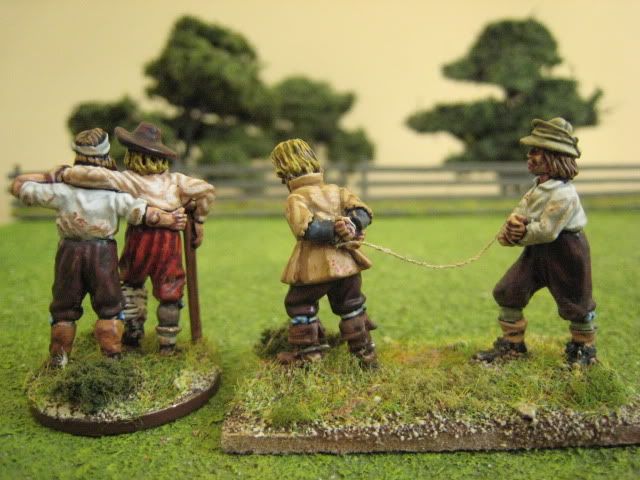
Saturday, 4 July 2009
ECW wip
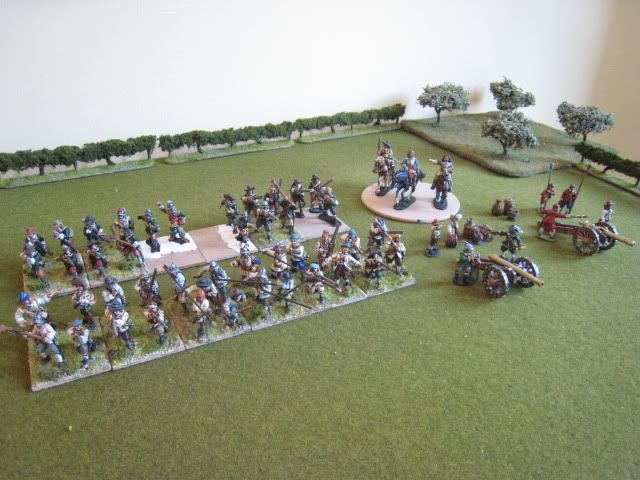
A couple of people asked how my ECW project was developing, so while I work up my next Carlist War post I thought I'd post a couple of pics showing the current status of my Royalist army. There is no particular "army" in mind for this collection, i.e. it is not especially based on the Oxford army or that of Lord Hopton. My second regiment of foot is close to completion (Northampton's Greencoats). I am still working out how I want to base my artillery pieces (the ones here are by Warlord and Perry, clearly dwarfed by the Bicorne mounted command figures behind them). The three command figures will be added to so that they form an overall army commander stand and a cavalry commander stand. The current plan is to paint 4 foot regiments and then turn to cavalry for a bit, before adding to the foot and doing a few extra bits and bobs. For rules, "Eclaireur" and I are thinking of "Forlord Hope". Philadelphian wargaming chum "Bede" has just asked on TMP whether Forlord Hope works on a IGO/UGO basis; it's a valid question as the rules don't actually ever make this clear...
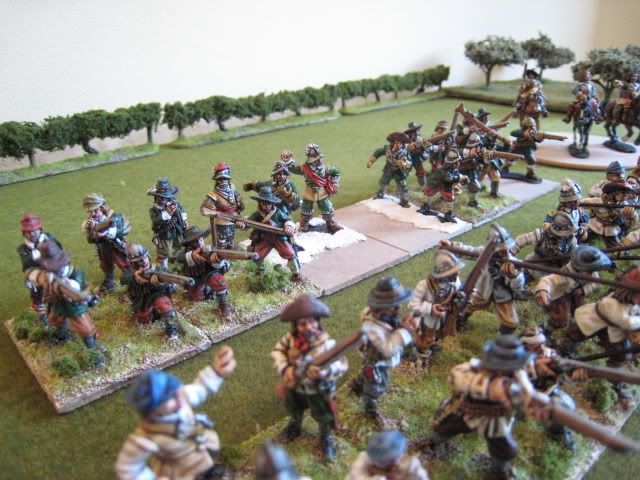

Saturday, 20 June 2009
ECW Interlude (1)
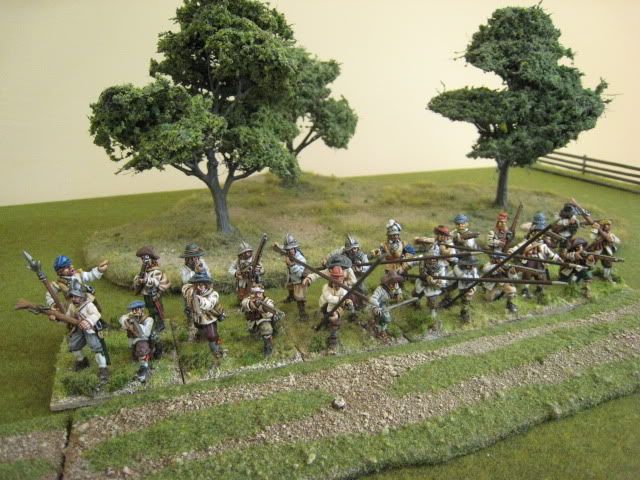
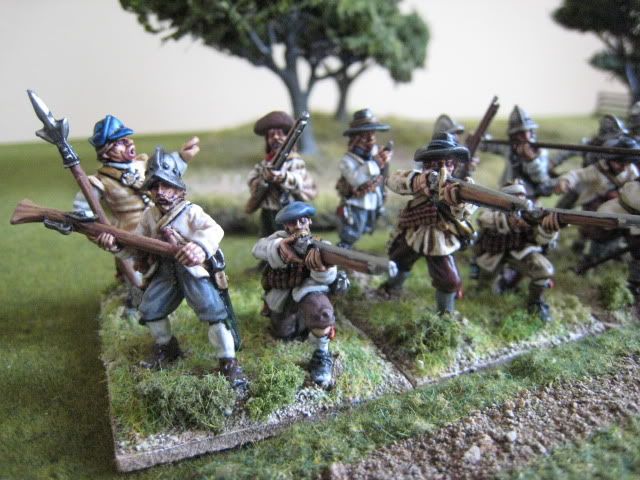
In addition to the First Carlist War, I'm currently also working on a Royalist army for the English Civil War. This is the first completed infantry regiment. It's currently lacking flags, but it's going to take me a while to work those out so I thought I'd post these pics anyway. This unit is nominally the Marquis of Newcastle's Regiment, one of the whitecoated regiments that fought at Marston Moor. Being part of the northern Royalist army, a couple of the soldiers have blue scottish caps. The white coats themselves are in various shades to add variety, but I tried to unify the regiment by painting the caps and monteros light blue.
I painted the left hand pike stand back in August 2007 and always meant to finish off the unit - but in those days it was non-stop AWI. But now I have sufficient motivation to have a good crack at the ECW and I happily confess to really enjoying painting these figures. The toys are a mix of Renegade and Bicorne - the former are larger than the latter, but not dramatically so and I don't think the difference matters in the same unit (I wouldn't mix Perry and The Assault Group in with Renegade and Bicorne). The larger size of the Renegade figures means a deep base is required - the bases here are 40mm x 50mm instead of 40mm x 40mm, which seems to be the standard for many sets of ECW rules. I um-ed and ah-ed over base sizes for ages, and owe thanks to wargaming chum Timmo (highly experienced in ECW) for helping me resolve this and other conundra. My opponent, Mr Eclaireur who is collecting Parliament's forces, is going for the new Warlord plastic figures and Perry. I have recently painted gun crews from those two manufacturers and they mix together very well. I'm looking forward to spending more time with the ECW; the only problem with the period is that all the pikes make storage rather tricky...
24 figures. Painted August 2007 and May 2009. The rubber road was made by Kerry Thomas (aka NZ's "Valleyboy"), whose excellent "how-to" article is in issue 16 of Battlegames magazine.
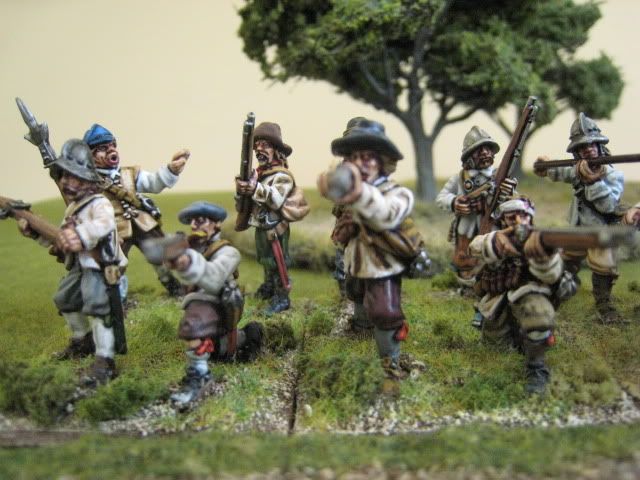
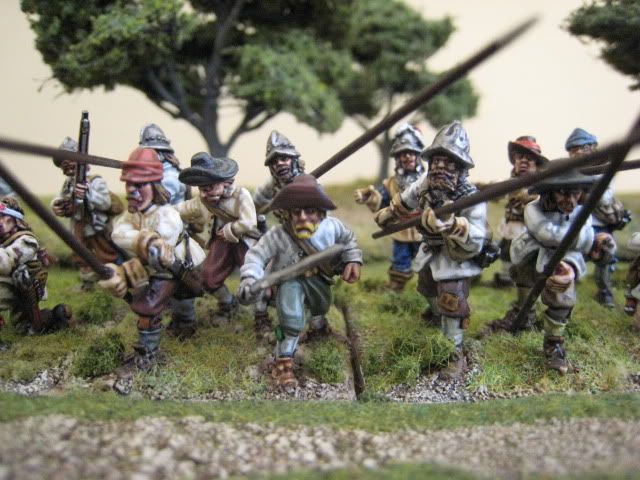
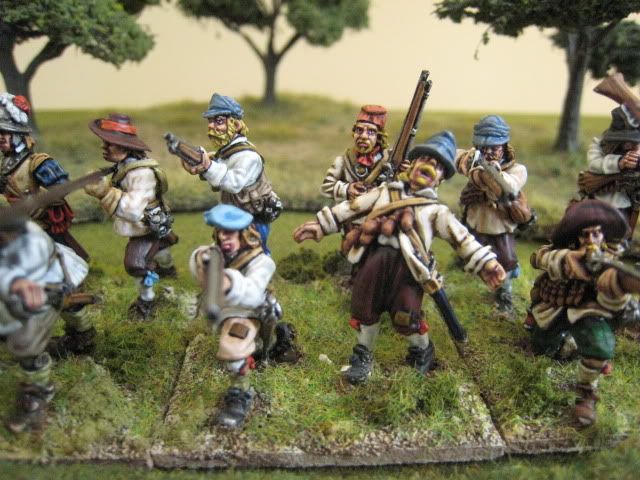
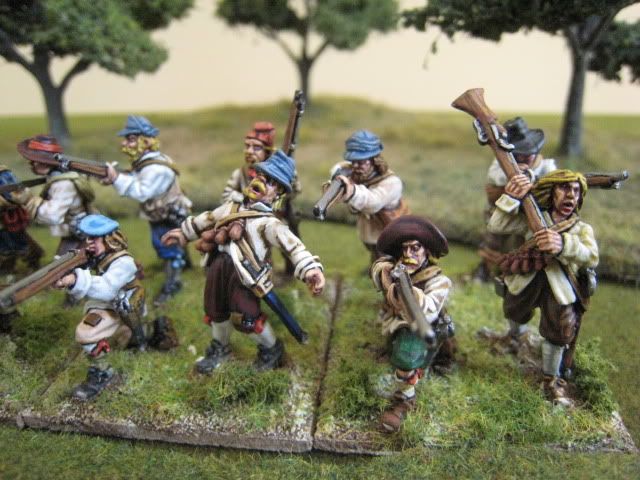
Subscribe to:
Comments (Atom)









